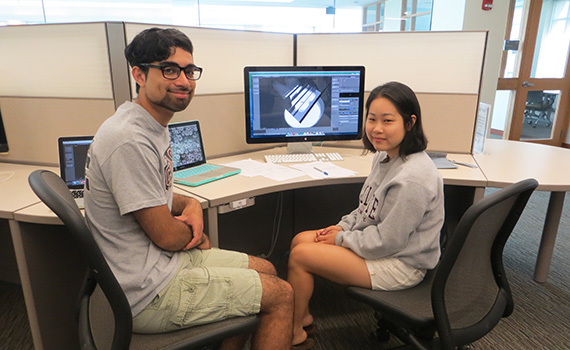
Eli Goberdon ’16 and Junghyun Seo ’16 have been working with Professor Elodie Fourquet on a project to improve lighting in 3D environments.
şÚÁĎÍř students are sharing their experiences conducting research with faculty members on campus and in the field. This post is by Eli Goberdon ’16, a major from Scranton, Pa.
I have a fascination with storytelling, especially storytelling through the use of computers. One way stories are conveyed through computers is 3D graphics software.
Artists can use 3D graphics software to create still images, animated films, and video games. One of the most essential parts of generating any realistic scene in 3D graphics is proper lighting. Lighting in 3D software is done by placing lights, manipulating shadows, and working with ambient illumination.
I worked with and Junghyun Seo ’16 on a project that would improve controls for lighting in 3D environments.
For our research we looked into lighting techniques from an older art form — theater — and sought to use them for improving lighting in 3D graphics software. To do this, we sifted through massive amounts of information on theater lighting techniques.
For example, in 3D lighting, lights are often placed in specific arrangements and numbers known as lighting “rigs.” Theater also precisely constructs lights in specific arrangements, so working with the theater guidelines allowed us to explore new modes of setting up lights in 3D graphics software.
This project allowed me to see how 3D graphics artists manipulate light to help tell their stories. Besides just adding visibility to a scene, the nuances of lighting in 3D convey complex things like mood. Often, lighting is very difficult and cumbersome in three dimensions, especially for people new to 3D graphics software. This is mainly because there are myriad options to control, an infinite space to put lights in, and parameters that do not often act like their real-world equivalents.
This was a great opportunity to figure out all the responsibilities and challenges of doing research in a work environment. It has also greatly improved my knowledge about 3D graphics software, giving me a new set of skills. I now understand how artists use 3D graphics software to light scenes that are convincing and beautiful.
I was drawn to this research because it relates to my academic, personal, and computer science interests. The opportunity to work with Professor Fourquet helped me to get more involved with the department where I will spend most of my şÚÁĎÍř career.
I would like to pursue work that involves creating 3D-graphics-based video games or other art. Therefore, this research has allowed me to experience a part of what I hope to continue working with in my field — whether it’s video games or animated film.
